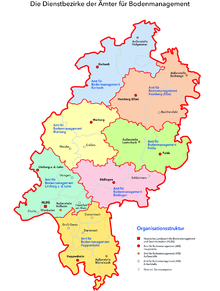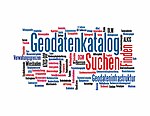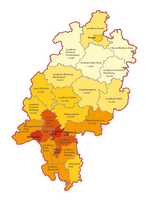Hessian administration for land management and geoinformation
|
Hessian Administration for Soil Management and Geoinformation (HVBG) |
|
|---|---|
| State level | State of Hesse |
| position | Central Authority |
| legal form | State authority |
| Supervisory authority | HMWEVL |
| founding | January 1, 2005 |
| Headquarters | Wiesbaden |
| Authority management | Johannes Gerhard Terlinden , President |
| Servants | 1,600 |
| Web presence | hvbg.hessen.de |
The Hessian Administration for Soil Management and Geoinformation (HVBG) is an administration of the State of Hesse with around 1,600 employees. It is divided into the Hessian State Office for Soil Management and Geoinformation (HLBG, central authority) and seven offices for soil management (ÄfB) with external and contact points. The HVBG unites the land surveying , cadastral and land consolidation authorities in Hesse. One of the core competencies is managing the real estate cadastre; it thus secures property in the land. The HVBG also promotes the sustainable and environmentally friendly development of rural and urban living spaces with the instruments of land consolidation and urban land planning law. With the data from the real estate cadastre and the national survey, it provides basic geographic data as the basis for numerous specialist information systems. It maintains a uniform official spatial reference for positioning all property and landscape-related information. The HVBG takes care of the coordination of the spatial data infrastructure Hessen, over which the available spatial data can be used meaningfully. With the offices of the expert committees for real estate values GAA, HVBG creates transparency on the real estate markets in Hesse by determining and providing current market data .
history
The real estate cadastre emerged from the endeavor to raise fair taxation for property (tax cadastre). In the middle of the 17th century, the term cadastre was introduced for the taxation of land. The measurement of properties and their representation on large-scale maps began at the end of the 17th century. So-called land surveyors, today's geodesists , divided the land into parcels . The boundaries of the parcels in the area were then marked by stones or stakes.
In the 18th century the tax cadastre was also used for other purposes, for example for the proper proof of the landowner. This development continued with the enactment of the Prussian Land Register Ordinance in 1872 and the Reich Land Register Ordinance of March 24, 1897. According to this, land must be proven in the land register according to the land registry. Since then, the real estate cadastre has been used in combination with the land register to secure property ownership. In the land register, the legal relationships are described, "the real estate cadastre deals with the representation of the actual circumstances, without which an identification of the properties in the location would not be possible."
While the tasks of the real estate cadastre were carried out by civil authorities from the beginning, the military took on the work of land surveying for a long time. These were only later transferred to civil authorities. The triangulation of the 1st to 3rd order, for example, was completed in 1860 by the Land Surveying Commission founded in 1853; the coordinates recorded were published in 1863. However, the state surveying commission disbanded in 1868 after only 15 years.
The expansion of the work in surveying led to a reorganization compared to the 19th century, in which the work could be carried out more efficiently. As early as 1934, the law on the reorganization of surveying came into force and became a matter for the Reich. The law on the formation of main surveying departments (HVA), which came into force on April 1, 1938 , brought about decisive organizational changes . The 14 HVA formed were subordinate to the Reich Minister of the Interior (RMdI). The HVA XI was built in Wiesbaden, which was attached to the Prussian government president there. The administrative areas included the Prussian administrative districts of Kassel and Wiesbaden, the state of Hesse, the Bavarian administrative district Palatinate and the Saarland. The borders thus went well beyond what is now the state of Hesse. The tasks included:
- "Establishing and maintaining the 2nd to 4th order triangulation (state triangle and recording networks) and monitoring of the realm fixed point field (1st order triangulation),
- Editing, updating and printing of the topographic national maps,
- possibly further tasks assigned by the RMdI. "
The war year 1944 brought about changes again. On September 30, 1944, the Council of Ministers for the Defense of the Reich issued an ordinance on the simplification and standardization of cadastral and surveying . For the first time, all areas of this subject were subordinate to the Reich authorities and the Reich Minister of the Interior. State and cadastral surveys were also organizationally combined. The HVA XI acted as an intermediate authority to which the cadastral authorities were subordinate. However, it was never implemented because land surveying and cadastral work came to a standstill during the war years.
The Prime Minister of the State of Greater Hesse (today's federal state of Hesse) decided on instructions from the military government on November 10, 1945 that the Minister of Finance (MdF) should head the HVA XI from now on. With a decree of February 13, 1946, this regulated the organization of the land and cadastral surveying. The HVA XI remained unchanged, the authorities at the district level used the designation land registry office. At this point in time the national territory and administrative district of HVA XI coincided for the first time.
The Hessian Minister of Finance (HMdF) ordered a reorganization of the Hessian land surveying system on August 12, 1947 to simplify and improve the economic structure. The top management was given to Department VI (Cadastre and Surveying) at the HMdF. The HVA XI received the name Hessisches Landesvermessungsamt (HLVA) in the function of a middle authority with four subdivisions administration, surveying department, cartography and cadastre, seat was Wiesbaden. The HVLA now performed all of the state surveying tasks for Hesse. The tasks included:
- "Production, maintenance, renewal and monitoring of the triangular and elevation networks, topographical and photogrammetric work, cadastral remeasurements, etc.,
- Production, maintenance and duplication of the official map series,
- Creation of new real estate cadastre,
- Execution of cadastral surveys and other large-scale surveys. "
The HLVA supervised the land registry offices.
Since 1959, the HLVA has done pioneering work in the field of data processing for trigonometric and cadastral surveys. Through a law of March 18, 1970 and a resolution by the state government on November 25, 1971, the Hessian Minister for Economics and Technology (HMfWuT) was responsible for public surveying and replaced the HMdF. This continues to this day.
The Land Surveying Act of March 16, 1970 brought legal unification for Hessen in land surveying. The HLVA became the upper state surveying authority, the land registry offices the lower state surveying authorities. With the functional reform in 1977, the status of the land registry offices changed. They were spun off from the cadastral and surveying administration at that time as a special administration and integrated with the district administrator or mayor as the authority of the state administration. The HLVA, which was not affected by the reform, continued to act as an intermediate authority. In 2001 the cross-district allocation of the area of land consolidation and, for a period of about two years, the area of village and regional development . Thus from 2001 to 2003 the administration was called the Hessian Administration for Regional Development, Cadastre and Land Reorganization (HVRKF), after the re-outsourcing of the village and regional development Hessian Administration for Cadastre and Land Reorganization (HVKF).
In order to optimize the administrative structures, seven offices for land management (ÄfB) with main, branch and contact points were formed from the lower state surveying, cadastral and land consolidation authorities on January 1, 2005. Together with the Hessian State Office for Soil Management and Geoinformation (HLBG), the previous HLVA, the ÄfB combine the areas of land surveying, cadastre and land consolidation in a specialist authority under the name Hessian Administration for Soil Management and Geoinformation (HVBG).
organization
As the highest state authority, the HVBG presides over the Hessian Ministry of Economics, Energy, Transport and Housing (HMWEVW).
The HVBG is composed of the HLBG as the intermediate authority based in Wiesbaden and the seven ÄfB Büdingen , Fulda , Heppenheim , Homberg (Efze) , Korbach , Limburg an der Lahn and Marburg .
The president takes over the management.
The HLBG divided into divisions and departments . The ÄfB consist of departments and departments.
tasks
The core tasks of the HVBG are in the area:
- the national survey
- of the real estate cadastre
- the spatial data infrastructure
- the land consolidation
- the urban land order
- the real estate appraisal and
- of training
Land survey
By means of a satellite-supported positioning service ( SAPOS ) as well as the location, height and gravity ( fixed point fields ), the HVBG's land survey ensures the geodetic spatial reference in a nationwide coordinate system . This spatial reference results in a clear positioning of all property and landscape- related information. It can also be used to link technical data from different areas and present them together. “The topographical land survey records and describes the real landscape and the natural relief of the terrain. The information obtained is managed and kept up-to-date in a nationwide information system ( ALKIS ) and topographical maps derived from it . In addition, aerial photos and other remote sensing data are available across the board. ”The HVBG creates u. a. topographic land cards works , area maps, leisure maps, presentation graphics, historical maps and aerial photographs.
Real estate cadastre
The real estate cadastre shows all parcels and buildings across the board and always up to date . Together with the land register, it serves to secure property ownership. It also gives it marketability and creditworthiness. Public law stipulations (e.g. protected areas) and agricultural land appraisals are also kept in the real estate cadastre . It is an indispensable basis for infrastructure measures that take up space and the associated right-hand traffic on land. "Changes to the properties are recorded by cadastral surveys in the location and incorporated into the real estate cadastre." The HVBG has the statutory task of " recording properties , keeping them in the real estate cadastre and updating them." Properties according to the Hessian law on public surveying and geographic information systems (HVGG) are land (parcels) and buildings. The measurement is considered evidence of the property.
The HVBG performs the following activities here:
- Dismantling measurements for the purpose of dividing the property
- Determination of the property boundaries in the locality ( boundary determination ) and marking of the boundary points
- Measurement of buildings and other structures within the framework of the legal requirements
- technical and procedural processing of land regulation measures, such as re-routing according to the Building Code (Land reassignments, simplified reassignments) and boundary cleanup sverfahren after the Hessian boundary cleanup law .
Spatial data infrastructure
A spatial data infrastructure (GDI) is made up of basic and specialist geographic data from the state, metadata and standardized services ( spatial data services ). The services are accessible through standardized interfaces and online services with the aim of enabling simple use of the geodata that is otherwise distributed. In this way, for example, decision-making processes can be accelerated and optimized. In addition to technical components, organizational framework conditions must also be taken into account.
This results in the following advantages:
- better dissemination of information
- Accelerated business processes that are easier to support through the merging of geospatial data and services
- cost-effective and efficient administrative action
- good availability of data and information based on it for business, administration and citizens.
The legal framework for the development of the SDI is the INSPIRE Directive 2007/2 / EC of May 15, 2007. In order to exchange, share, access and use interoperable spatial data and services across the different administrative levels and sectors of the European To ensure across the Union (EU), it obliges all public administration bodies to provide geospatial services for specific specialist topics, including metadata. The development of the GDI is directed and coordinated in Germany by the GDI-DE. For the GDI-Hessen there is the central competence center for geographic information in the HLBG. It operates the central technical components.
Land consolidation
Land consolidation is a land management procedure for the implementation of rural planning. Preserving, shaping and developing the cultural landscape is one of the central tasks. The land consolidation thus makes a decisive contribution to improving living conditions in rural areas. Measures are:
- Improvement of the agricultural structure
- Landscape development
- near-natural development of waters and floodplains
- Extensive environmental protection for the protected goods animals, plants, climate, water and soil
- Appreciation of the landscape-related leisure and recreational function
- Transport infrastructure and
- Village renewal
The EU, the federal government, the state and the property owners jointly bear the costs. Through planning, coordination, financing, structural improvements and the reallocation of the plots, the tasks of land reorganization can be bundled in one place and carried out from a single source.
The legal basis is the Land Consolidation Act (FlurbG). There are five different land consolidation procedures , which are selected according to the respective needs. These are:
- the traditional integral land consolidation (§ 1 FlurbG, for the comprehensive development of rural areas)
- the simplified land consolidation for land development (§ 86 FlurbG, for individual purposes, e.g. to improve the agricultural structure or design of the locality and landscape)
- the company land consolidation (§ 87 FlurbG, for the socially and environmentally compatible implementation of road construction projects, etc.)
- the accelerated amalgamation (§ 91 FlurbG, a fast procedure with a purely land management orientation)
- the voluntary land swap (Section 103 FlurbG, a procedure if the swap partners agree).
Urban zoning
The reallocation of building land is a land management procedure for urban planning. A legally binding development plan forms the basis. Property boundaries and ownership will be rearranged so that suitable building plots will be created. In addition, further areas required for development must be created ( internal development ). The assignment is carried out independently by the respective municipality (assignment office). The municipal council or city council orders this. The ÄfB provide advice and support here, but can also carry out reallocations on behalf of the municipality. The ÄfB carry out the following tasks:
- Implementation of urban planning [...]
- Elimination of inappropriate boundaries
- Elimination of conditions contrary to building law
- Avoidance of splintered parcels after road construction.
Real estate appraisal
The expert committees for real estate values (GAA) work independently and independently in Hesse for 21 districts, 5 cities and 19 cities belonging to the district. The tasks of the GAA are carried out either in the office at the ÄfB or by the respective city council.
In addition to the statutory tasks according to the Building Code , the expert committees perform the following tasks:
- Determination of generalized land values to compare the land value level
- Creation of rental value overviews to determine average rents for living space
- Creation of the real estate market report on market transparency (regional and national)
- Preparation of valuation reports on other rights and encumbrances on land, land in redevelopment and development areas as well as rental and lease values
- Calculation of comparison factors for a simple appraisal of the value of standard properties
The central office of the expert committees for real estate values of the state of Hesse (ZGGH) was set up in 2007 at the HLBG for all ATMs. She wrote u. a. the nationwide real estate market report and publishes generalized land values.
In cooperation with the GAA, it presents comparative factors from the State of Hesse for single and two-family houses, terraced houses and semi-detached houses as well as condominiums. These comparison factors allow a quick assessment of the value of standard properties.
In addition, the ZGGH supports the GAA by
- ensures the national uniformity of the data and products to be collected by the ATMs,
- coordinates the transfer of data (which is outside the area of responsibility of an ATM) to third parties,
- Binding standards and business models developed for data marketing by third parties,
- maintains the central website of the GAA and
- the Hessian land value information system BORIS.
Hessian State Office for Soil Management and Geoinformation (HLBG)
As an intermediate authority, the HLBG takes on tasks of fundamental importance, control and coordination tasks as well as specialist and service tasks, insofar as they are not performed by the ÄfB. Furthermore:
- the HLBG controls the HVBG. This includes the technical and service supervision of the ÄfB.
- the HLBG performs the statutory tasks of the upper land surveying, upper cadastral and surveying authorities as well as the upper land consolidation authority,
- the HLBG performs the tasks of the ZGGH,
- the HLBG performs the tasks of the Central Competence Center for Geoinformation,
- the HLBG performs the statutory tasks according to the Land Consolidation Act,
- the HLBG performs its own tasks in the areas of geodetic spatial reference, geotopography and cartography,
- the HLBG is responsible for the approval of publicly appointed surveyors and exercises the service and technical supervision of this group of people,
- the HLBG develops principles for the use of new work processes and technologies,
- the HLBG represents the state of Hesse within the framework of the delegated powers,
- the HLBG does other tasks after special assignment or agreement,
- the HLBG supports the training of young professionals.
Office for soil management (ÄfB)
The tasks of the ÄfB include:
- Establishment, management and quality assurance of the real estate cadastre,
- Tasks of national surveying,
- Establishment and management of geographic base information systems, provision of geographic base data and technical support for users,
- Tasks in the context of the development and maintenance of regional spatial data infrastructures,
- Management of property-related information and services,
- Implementation of proceedings according to the Land Consolidation Act,
- Accompanying further measures to promote integrated rural development,
- Technical and, if necessary, procedural implementation of procedures in accordance with the Building Code and the Border Adjustment Act,
- Tasks of the offices of the expert committees,
- Execution of property surveys,
- Notarization of facts on land,
- Representation of interests as a carrier of public interests,
- Training of young professionals "
- other tasks according to special assignment or agreement.
Web links
Individual evidence
- ↑ Geodata Infrastructure (GDI-Hessen) In: Hessian Administration for Soil Management and Geoinformation , accessed on May 9, 2017.
- ↑ Expert committees for real estate values In: Hessische Verwaltung für Bodenmanagement und Geoinformation , accessed on May 9, 2017.
- ↑ Real estate market reports in: Hessian Administration for Land Management and Geoinformation , accessed on May 9, 2017.
- ^ Exhibition for the 125th anniversary of land registry offices in the Duchy of Nassau in 2001, display board of the traveling exhibition in Frankfurt (March 23, 2001)
- ^ A b c d e f g Friedel Kern: The organizational development of the Hessian land surveying office. In: German Association for Surveying (DVW), DVW Hessen / DVW Thüringen-Mitteilungen 2/1989. 1989, pp. 3-6.
- ↑ a b c d H.P. Bertinchamp: From the main surveying department to the state surveying office. In: Allgemeine Vermessungsnachrichten (avn.) 11-12 / 1988. 1988, pp. 431-433.
- ↑ Gerd Krüger, Jörg Schnadt: Geodesy and Cartography in the Third Reich 1933 - 1945. In: geog.fu-berlin.de. Retrieved May 9, 2017 .
- ^ A b Gerd Köhler: The Hessian Administration for Land Management and Geoinformation - a newly organized administration with a future! -. In: German Association for Surveying (DVW), DVW Hessen / DVW Thüringen-Mitteilungen 1/2005. 2005, pp. 31-32.
- ^ Astrid Freese: Hessian Land Surveying Office. (PDF) Section 541. In: Repertories Hessisches Hauptstaatsarchiv Wiesbaden. November 2009, accessed February 24, 2014 .
- ↑ HLBG organization chart ( page no longer available , search in web archives ) In: Hessisches Landesamt für Bodenmanagement und Geoinformation . April 7, 2017, accessed on May 4, 2017 (PDF; 41 kB)
- ↑ organizational charts of the AIFB In: Hessian Department of Land Management and Geoinformation . Retrieved May 4, 2017.
- ↑ Land surveying In: Hessian administration for soil management and geographic information . Retrieved May 4, 2017.
- ↑ a b real estate cadastre . In: Hessian Administration for Soil Management and Geoinformation , accessed on May 4, 2017.
- ^ Hessian law on public surveying and geographic information (Hessian surveying and geographic information law - HVGG). In: rv.hessenrecht.hessen.de. 2008, accessed June 2020 .
- ↑ Law on the simplified adjustment of legal and boundary conditions in construction work for public roads (Border Adjustment Act). In: rv.hessenrecht.hessen.de. 1979, accessed June 2020 .
- ↑ Urban land order . In: Hessian Administration for Soil Management and Geoinformation , accessed on May 9, 2017.
- ↑ GDI . HVBG website. Retrieved May 4, 2017.
- ↑ Geoportal Hessen and geodata online ( Memento from September 5, 2012 in the Internet Archive ). HVBG website. Retrieved May 4, 2017.
- ↑ Reorganization of the land . HVBG website. Retrieved May 4, 2017.
- ↑ Land management . HVBG website. Retrieved May 4, 2017.
- ↑ HAGFlurbG (Land consolidation implementation law) In: Beck-Online , accessed on May 9, 2017.
- ↑ Integralflurbereinigung ( Memento from May 14, 2014 in the Internet Archive ) In: hvbg.hessen.de , accessed on May 9, 2017.
- ↑ Land reorganization in Hesse ( page no longer available , search in web archives ) HLBG brochure Overcoming boundaries ... Shaping the future! Edition 2016 (PDF; 1.39 MB)
- ↑ Reallocation of building land . HVBG website. Retrieved May 4, 2017.
- ↑ Tasks for land management ( page no longer available , search in web archives ). HVBG land regulation folder, 2013.
- ↑ a b Advisory Committee . HVBG website. Retrieved May 4, 2017.
Coordinates: 50 ° 5 ′ 17 ″ N , 8 ° 13 ′ 33 ″ E








